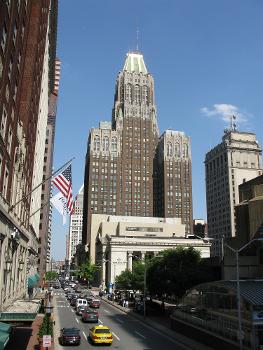General Information
| Other name(s): | Baltimore Trust Company Building; Nationsbank; 10 Light Street |
|---|---|
| Completion: | 1929 |
| Status: | in use |
Project Type
| Function / usage: |
Office building |
|---|---|
| Architectural style: |
Art Deco |
Location
| Location: |
Baltimore, Maryland, USA |
|---|---|
| Address: | 10 Light Street |
| Coordinates: | 39° 17' 21.12" N 76° 36' 50.76" W |
Technical Information
Dimensions
| height | 155 m | |
| number of floors (above ground) | 37 |
Excerpt from Wikipedia
The Bank of America Building, also known as 10 Light Street and formerly as the Baltimore Trust Company Building, is a 34 story, 155.15 m (509.0 ft) skyscraper located at the corner of East Baltimore and Light Streets in downtown Baltimore, Maryland.
Description
10 Light Street was the tallest building in the state, and the tallest office building in the United States south of New York City when constructed in 1929. The Art Deco building was designed by the firm of Taylor and Fisher, and completed in eighteen months, fashioned from Indiana sandstone and local brick over a steel frame at a cost of (U.S.) $3 million.
The building's exterior is decorated with carved Romanesque human and animal images, stylized eagles, and is capped with a copper and gold roof. The ornate, two-story main banking lobby is highly decorated with mosaic floors designed by Hildreth Meiere, and historic murals by Griffith Baily Coale and McGill Mackall on historic themes: the Baltimore fire of 1904, and the writing of the National Anthem at the Battle of Baltimore during the War of 1812. These mosaics are planned to be covered by artificial turf, so that the historic lobby can be used as an Under Armour gym.
History
Shortly after the Baltimore Trust Company moved into the building in 1929, the Great Depression began and the company foundered. The building was essentially vacant within a year, as the bank went into bankruptcy in 1933 and receivership in 1935. The empty building was subsequently used by the New Deal's Public Works Administration in Maryland.
From the 1940s into the 1960s, the building was first known as the Mathieson Building and then the O'Sullivan Building, reflecting ist then-current major tenants.
During those years, Semmes, Bowen and Semmes, a major Maryland law firm with origins in the 19th century, occupied the twenty-first floor, and later as many as four whole floors (when the firm employed almost 150 attorneys), remaining in 10 Light Street until approximately 1990, at what was called the "Baltimore Trust Building", according to the 1952 memoir of Whittaker Chambers, whose Semmes attorneys were Richard F. Cleveland (youngest son of President Grover Cleveland) and William D. Macmillan.
In 1961, the building was purchased by Maryland National Bank, successor of Baltimore Trust, and the building name was changed to "Maryland National Bank Building". Maryland National was itself purchased by NationsBank in 1993, and the name of the building was changed again, to "NationsBank Building". The structure then obtained ist current name following the NationsBank merger with BankAmerica in 1997. Major portions of the building were restored, including the copper-clad dome, which is once again floodlit at night.
In December 2012, the building was acquired by a Virginia firm which plans to convert all floors above the fourth into 445 residential apartments. Bank of America announced that it would close the ground floor banking center in May 2013. Miles & Stockbridge, a prominent Baltimore law firm, had maintained offices in the building since 1932 when one of the firm's founders, Clarence Miles, moved into the building.
Text imported from Wikipedia article "Bank of America Building (Baltimore)" and modified on July 23, 2019 according to the CC-BY-SA 4.0 International license.
Participants
Relevant Web Sites
- About this
data sheet - Structure-ID
20021280 - Published on:
04/05/2006 - Last updated on:
29/12/2021


.jpg)




